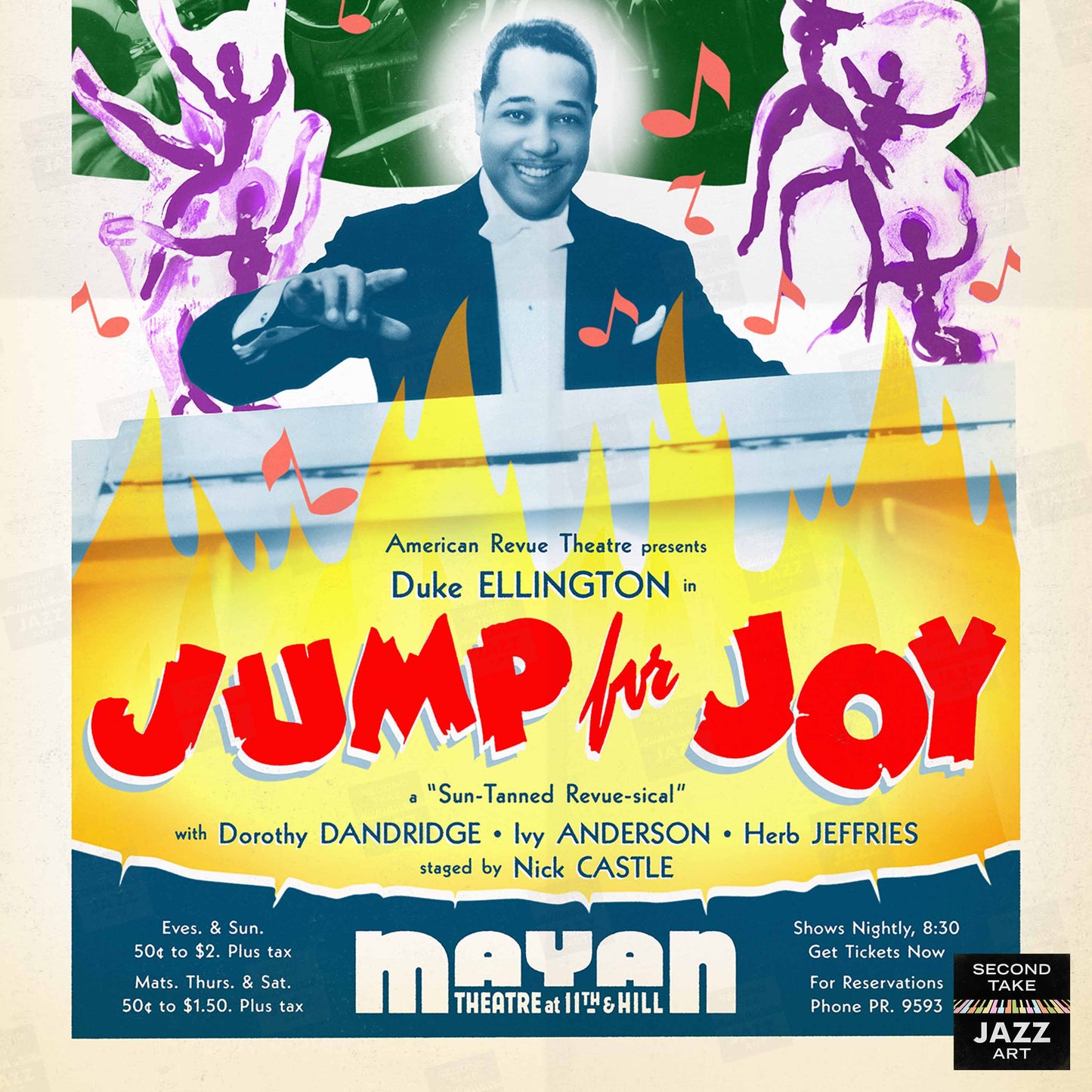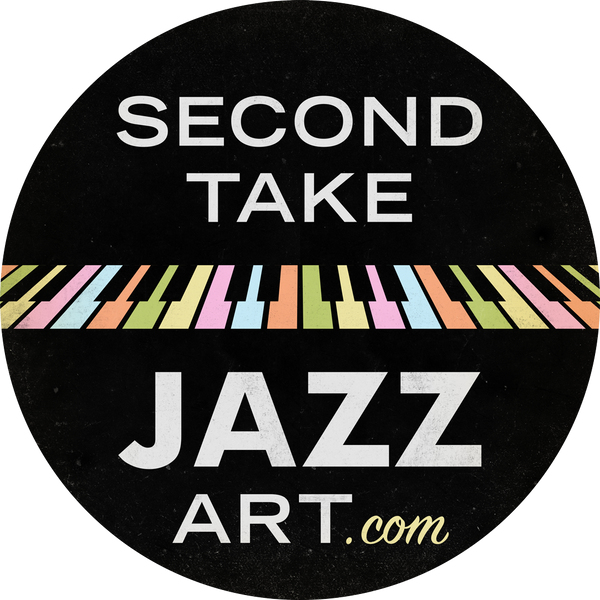Duke Ellington jazz poster - Jump for Joy - Los Angeles - 1941
Duke Ellington jazz poster - Jump for Joy - Los Angeles - 1941
- IN STOCK
- READY TO FRAME
- FREE U.S. SHIPPING
Couldn't load pickup availability
SecondTakeJazzArt presents...
a high-quality unframed poster featuring original upgraded artwork commemorating one of the most famous live performances in jazz history:
Duke Ellington
in
"Jump for Joy"
the all-Black musical revue premiering July 7, 1941 at the Mayan Theatre in Los Angeles, California
starring Dorothy Dandridge, Ivy (aka Ivie) Anderson, Herb Jeffries, Marie Bryant, Judy Carol, Artie Brandon, Al Guster, the Hi-Hatters, Lawrence Harris, Suzette Johnson, William Lewis, "Pot, Pan, and Skillet," Otis Renee, Wonderful Smith, Joe Turner, Paul White, and others
plus the classic Blanton-Webster Duke Ellington Orchestra *in the pit, playing live in every performance* featuring:
Johnny Hodges, Otto Hardwick (alto saxophone); Barney Bigard (clarinet, tenor sax); Ben Webster (tenor sax); Harry Carney (baritone sax)
Rex Stewart (cornet); Ray Nance (trumpet, violin); Wallace Jones (trumpet)
Tricky Sam Nanton, Lawrence Brown (trombone); Juan Tizol (valve trombone)
Duke Ellington (piano); Fred Guy (guitar); Jimmy Blanton (bass); Sonny Greer (drums)
Calling itself a "Sun-Tanned Revue-sical," Duke Elllington's "Jump for Joy" was lightning in a bottle. It was an original musical show — in 1941! — that had an all-Black cast and orchestra, daring to bare its social conscience by lampooning the rampant racism of the era. Financed in part by the Hollywood actor John Garfield, the show earned rave reviews and ran for 122 performances over 9 weeks. It was truly a star-studded revue that overflowed with talent and promise — it featured a cast of 60(!) actors, singers, dancers, comedians, and musicians; it included contributions from Langston Hughes, Billy Strayhorn, Mercer Ellington, Hal Borne, Paul Webster, Sid Kuller, Mickey Rooney(!), and many others; it developed interest from show business luminaries such as Orson Welles and Charlie Chaplin; and it even had (somewhat grandiose) ambitions of a big move to Broadway!
And as if all the scathing satire about Jim Crow and its challenges weren't enough, the revue also featured some truly outstanding Ellington-Strayhorn writing, like the title number "Jump for Joy"; the ballad "The Brown-Skinned Gal in the Calico Gown"; the moody Strayhorn serenade "Flame Indigo"; the catchy jive tune "Bli-Blip"; the dance number "The Chocolate Shake"; the blues swinger "Rocks in My Bed"; and most enduringly, "I Got It Bad (And That Ain't Good."
For a man somewhat prone to exaggeration and self-aggrandizement, Ellington once called "Jump for Joy" "the hippest thing we ever did" — for once, he might have not been gilding the lily. :-)
Note: This poster is directly derived from vintage program and poster source materials from the show.
https://en.wikipedia.org/wiki/Jump_for_Joy_(1941_revue)
IMPORTANT INFO
IMPORTANT INFO
1) Our posters are new. First and foremost, all our posters are MODERN CREATIONS — they are NOT vintage pieces or antiques! Our posters are printed on-demand from our own ORIGINAL art files that we've created ourselves within the last few years. (Read on for more details.)
2) Bring your own frames. We offer our posters UNFRAMED ONLY! Many of our preview images demonstrate how our posters look framed in various real-world environments; however, these images are for ILLUSTRATIVE PURPOSES ONLY — we do NOT include frames when you order our posters! Offering our posters UNFRAMED ONLY helps us keep our production and shipping prices lower, allows us to offer FREE U.S. shipping on our posters, and lets our customers choose their own frame styles and materials to best match their taste, décor, and budget. (Thousands of inexpensive, easy-to-use framing options are available: with most, you just undo the clips on the back, slide in the poster, and redo the clips.)
3) Keep your cool. If you do wish to frame or mount our posters, do NOT use dry mount or heat press processes on them — doing so may DAMAGE them! Our posters are special digital prints that are prepared using vivid inks and finishes that can make them HEAT-SENSITIVE. (Instead, we recommend applying archival double-sided adhesive film; light misting with a pressure-sensitive archival spray adhesive such as Scotch/3M Spray Mount or Super 77; judicious application of archival double-sided tape; or mounting to peel-and-stick foam core/mounting board.) It's worth noting, however, that most folks who frame our posters skip adhesives altogether — they typically buy the right-size "ready to hang" frame for their poster and simply insert it freely into the frame. No muss, no fuss. Works like a charm!
4) Screens aren't paper. Please note that digital images are typically MORE VIBRANT than printed posters. Also, due to printing variations and editorial decisions, you can expect that the colors, details, etc. in the actual posters you receive may vary somewhat from their representations here. (Some preview images we show have been WATERMARKED for security purposes. Don't worry — these marks do NOT appear on the finished product.)
5) Perfectly imperfect. In general, our posters look what we like to call "PERFECTLY IMPERFECT." The events they publicize occurred in the distant past, and therefore the original source materials from which they derive often include not-so-minor COSMETIC FLAWS — folds, creases, scratches, spots, marks, smears, ghosting, discolorations, printing glitches, etc. In addition, some of the primary vintage advertising pieces contain TYPESETTING ERRORS — mistakes, typos, misspellings, etc. We elect to leave almost all of these issues INTACT. This serves to reflect the rushed nature of publicizing live jazz (with its often hurried programming and last-minute personnel changes), and when names are misspelled, these goofs reveal how some of the now-famous participants were still relatively early in their careers and not yet widely known. We always aim to strike a balance when preparing these "antique" materials for modern printing — holding onto their nostalgic, vintage-looking charm as much as possible — "warts and all" — while fixing issues primarily when they significantly hinder legibility. (Please be sure to ZOOM IN on our preview images to examine each poster closely.)
6) A best-in-class experience. Our thousands of satisfied customers agree: posters from SecondTakeJazzArt are an outstanding value! To print our superior-quality posters, we use state-of-the-art digital presses, special vivid inks and finishes, and premium paper stock (typically matte satin 80# cover stock [220 GSM] or 45# bond [170 GSM]). And we pride ourselves on providing truly exceptional customer service. (For your reference, our customer feedback is overwhelmingly positive, and our return rate usually hovers around 0.5% — just 5 units returned out of every 1,000 ordered — and most of those are exchanges!)
And where do these posters come from?
Our mission at SecondTakeJazzArt is to produce high-quality visuals that commemorate celebrated live performances by jazz legends from the distant past. We particularly focus on renowned club or concert appearances that have been preserved by fan-favorite recordings — legendary shows for which little to no advertising ephemera survives (or was ever created).
SecondTakeJazzArt strives to fill in these gaps with carefully researched, highly detailed facsimiles of said missing ephemera. Our poster designs combine the verifiable performance information with vintage source materials (imagery, branding, type, etc.) and original elements (derived from or inspired by contemporaneous advertisements of the same/similar events in posters, handbills, newspapers, magazines, festival programs, album covers, etc.).
In general, the posters we've created for SecondTakeJazzArt fall into three categories:
1) some are our own wholly new original designs; (aka, "recreations" — new posters that we've designed ourselves to commemorate specific gigs or concerts);
2) others are our own original enhanced designs (aka, "refittings" — new versions of vintage poster designs that we've significantly edited, adjusted, reconfigured, customized, etc. ourselves to commemorate specific gigs or concerts); and
3) some are our own original upgraded designs (aka, "reprints" — new straight reproductions of vintage posters that we've painstakingly retouched ourselves).
SecondTakeJazzArt produces decorative tributes that aim to delight the viewer, not forgeries or fakes that aim to deceive them. Our goals are to either faithfully recreate and/or authentically mimic something close to what might have been or reproduce in higher fidelity what's largely been lost.
We sincerely hope you do enjoy our posters, and find them to be worthy constituents of your home or office décor.
All posters designed and printed in the U.S.A.
Share

















